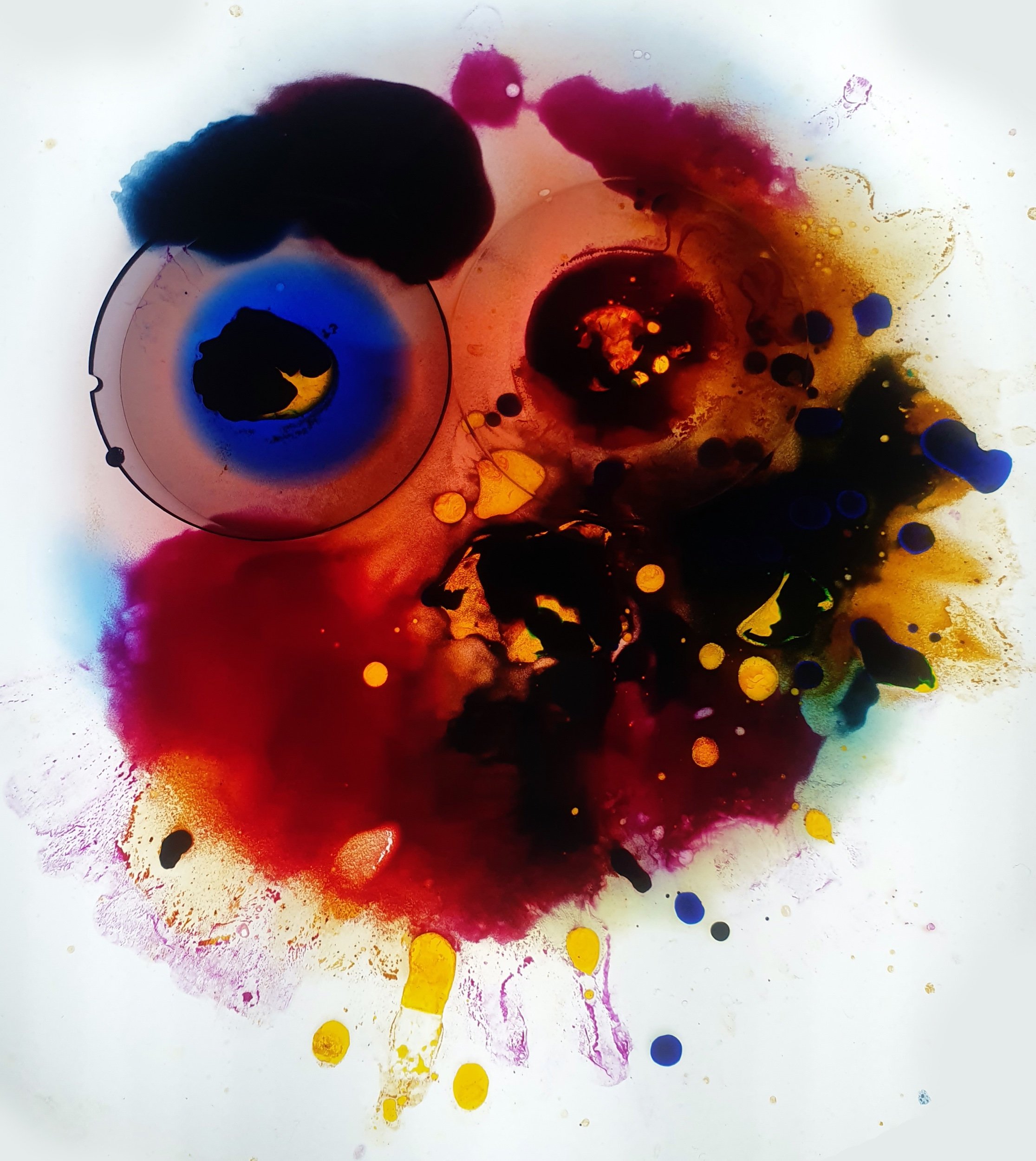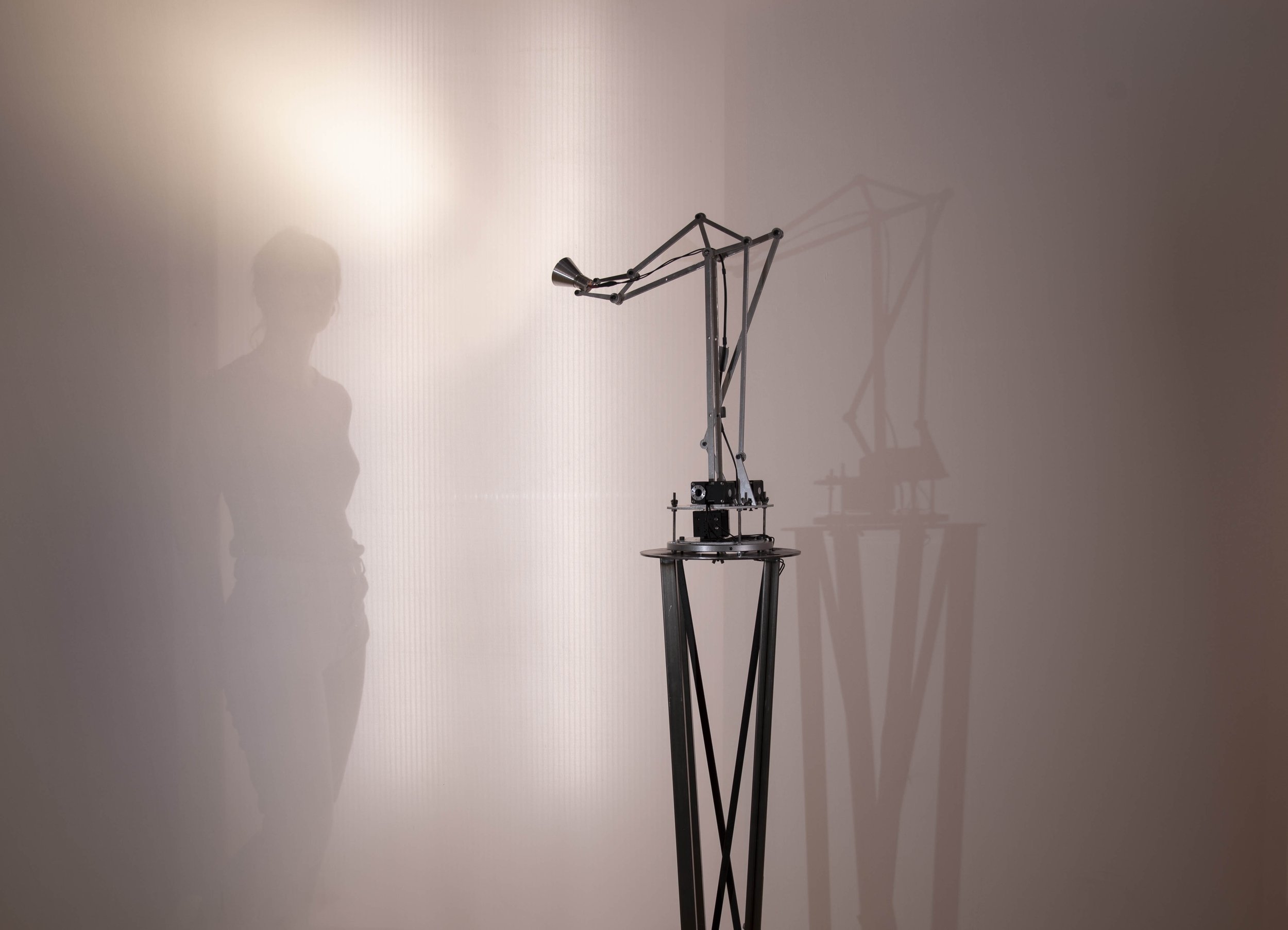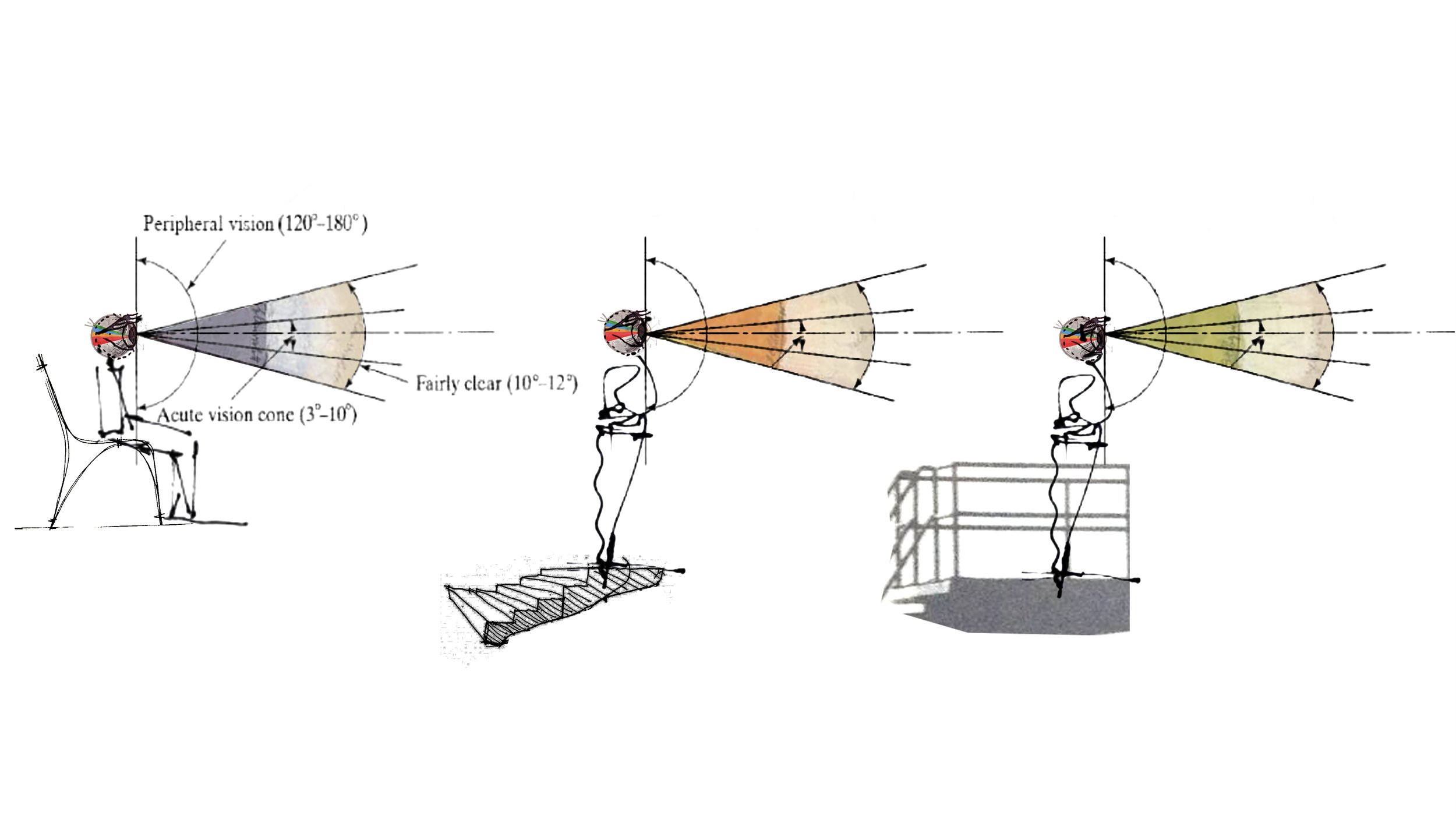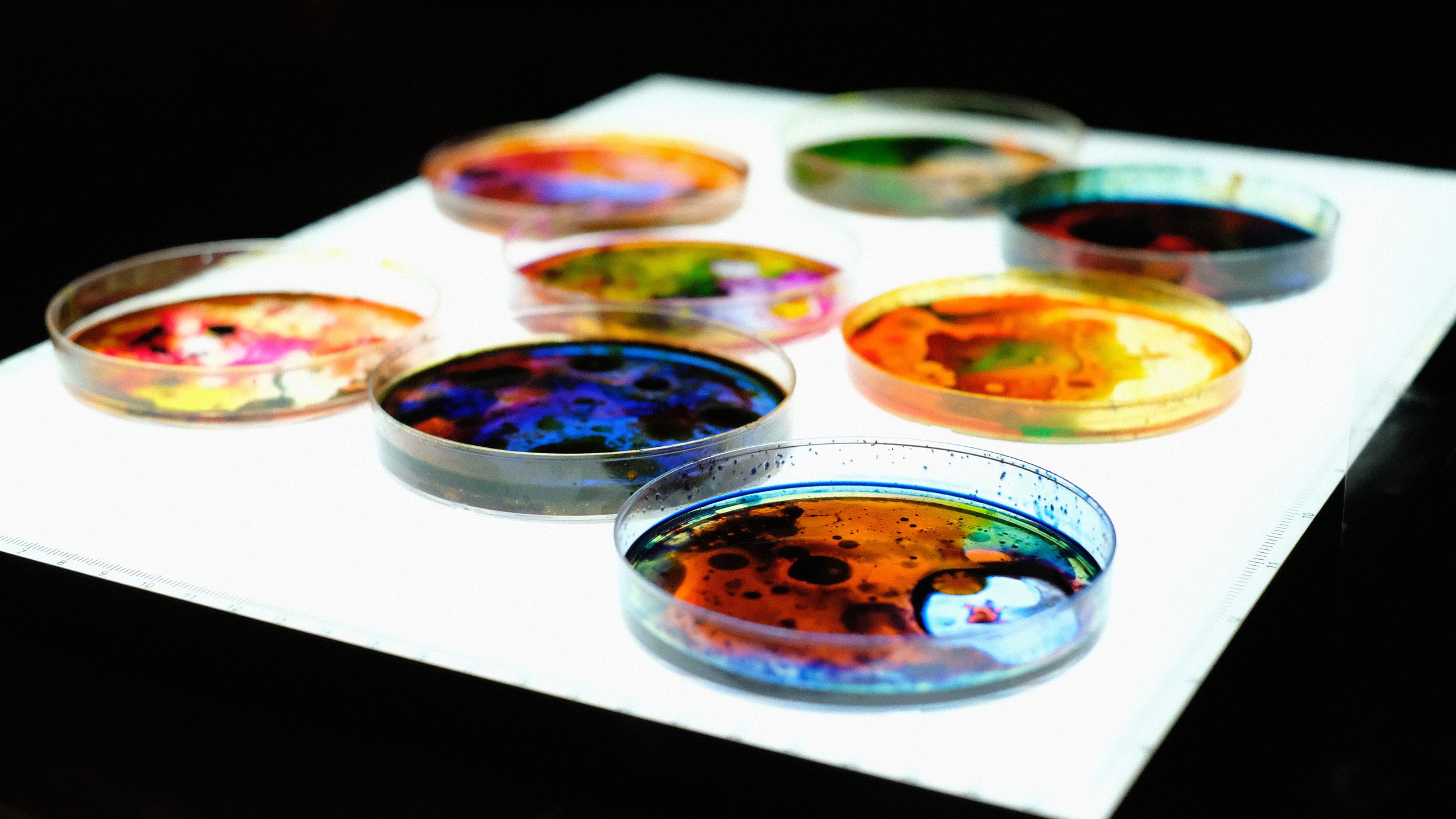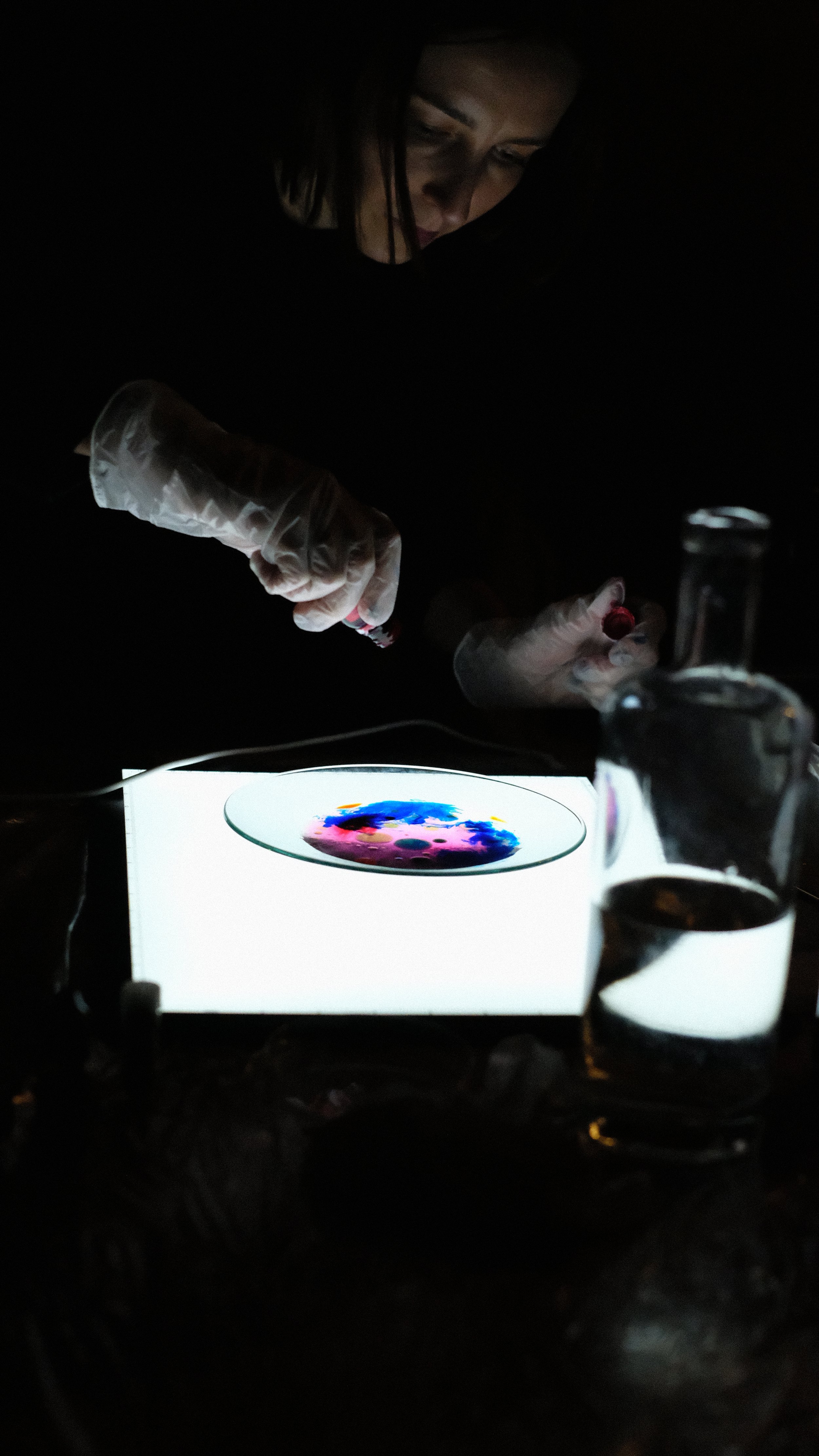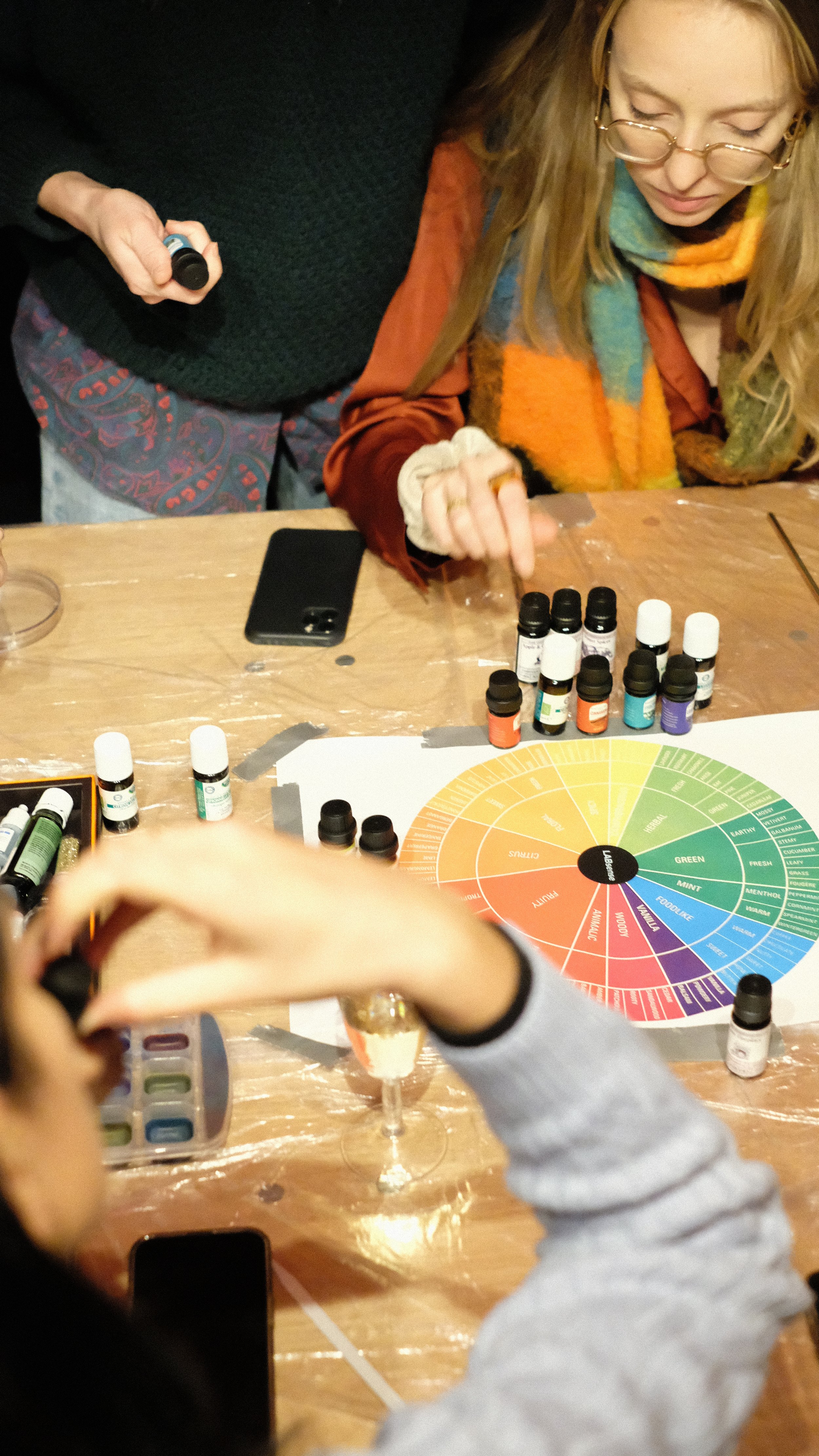013 SPOTLIGHT: ANNE-HÉLOÏSE DAUTEL
Anne-Héloise Dautel and Michael Wagner, Mushroom Umbrella, synesthetic live liquid light painting for Forgiveness music band, 2022
London-based creative director Anne-Héloïse Dautel is a registered architect and designer with strikingly distinctive vision. Her projects reveal a notably wide range of expertise and experience, including experiential and architectural design for Bompas & Parr (2019-2021), stage and light design for Waterperry Opera Festival (2021), working as a project architect in London, Belfast, and Shenzhen (2012-2018), creative direction and set design for Pinterest at DMEXCO, in collaboration with experiential marketing agency The Park (2022), and event concept and immersive design for ITV (2023).
Interestingly, however, the spaces and events that Dautel designs are not only filled with beauty, intrigue, and creative innovation, they are also grounded in significant scientific research, including her own collaborative work as a researcher at the Interactive Architecture Lab, part of the Bartlett School of Architecture, UCL. Here her investigations have centred around the role of wonder in aesthetic, perceptual, and interactive experiences, both in physical and digital environments. This research has primarily explored facets of visual perception, interpretation, and robotics, but, more recently, Dautel has also become involved in studies on olfactory systems and synesthesia – exploring analogies between these aspects of neurological functioning and live-painting. These explorations have resulted in a number of new projects, including a live painting and digital collaboration for a Salmon Universe label DJ set at Café Oto (2022), and the conceptualisation of LABsense (2022–), a series of art therapy workshops designed to enhance sensory perception through creative practices.
According to Dautel, these workshops not only aim to stimulate cognitive functions for those who take part, but they are also a way for her to deepen her own understanding of scientific inquiries into olfactory synesthesia, with a view to incorporating these concepts into her future work. We were interested to find out how collaborative and interdisciplinary working has helped Dautel to evolve as a creative consultant, and where her designs might lead audiences next.
Irem Bugdayci, Anne-Héloise Dautel, and Robert Wuss. Archives of Vision Making Of, 2019
Melissa Evans: Could you tell us about your professional background and your journey into interdisciplinary working?
Anne-Héloïse Dautel: My background lies in architecture and experiential design. Working in these disciplines has given me a useful foundation in interdisciplinary practices and a desire to branch out and explore spaces where science, behavioural psychology, and art intersect. Through my architectural practice, I developed a deep appreciation for the intricate relationship between aesthetics, technology, and the built environment. This appreciation led me to further explore these connections, which is why I decided to join the Interactive Architecture Lab at the Bartlett School of Architecture, UCL in 2018. During my time at the lab, I delved into the fascinating and magical realm of robotics and interactive art, which opened up a whole new world of possibilities in understanding perception, interactive experiences, and multi-sensory engagements. Exploring the frontiers of robotics and its profound connection to human perception deepened my understanding of the potential for merging scientific principles with artistic expression.
In my quest to further expand my creative horizons, I had the privilege of joining Bompas & Parr, a wondrous creative studio based in London, renowned for their groundbreaking work in culinary art, multi-sensory design, and events. Working alongside some of the most innovative minds in the industry was truly mind-altering. It allowed me to witness firsthand the transformative power of combining art, science, and immersive experiences to create unforgettable moments for audiences. Inspired by the amazing people I got to collaborate with and my experiences at Bompas & Parr, I took the leap and established my own art and design practice, specialising in creative direction for events and experiential design.
The journey from architecture to interactive robotics to creative direction has been a natural progression. Each step has expanded my perspective and equipped me with the skills and knowledge to create immersive experiences that engage, inspire, and challenge our perception of reality. I feel extremely grateful that I now have the opportunity to combine my passions for architectural design, conceptual thinking, behavioural psychology, art, and community engagement. Public art installations and events provide a unique platform for me to create meaningful experiences that resonate with my passions and people on a deeper level. By leveraging my architectural background, I can design installations that not only enhance the aesthetic value of a space but also spark dialogue, provoke emotions, and encourage community interaction.
Working in the realm of experiential marketing allows me to collaborate with diverse disciplines, including artists, psychologists, technicians, strategists and marketers, to create immersive brand experiences that leave a lasting impact on audiences.
ME: In 2022, you completed a project providing stage design and a live painting performance for a Salmon Universe label DJ set at Café Oto. Could you tell us a bit about how this design concept emerged and about the technicalities involved?
AHD: This project was a collaboration with Michael Wagner, a great experiential and lighting designer. Richard Pike, a musician from the bands Deep Learning and Forgiveness had asked him whether we could look after the stage design for a Salmon Universe label DJ set happening at Cafe Oto. Initially, Richard wanted us to set up ‘Gabriel’, the robotic cube that we had created together as part of Messiaen’s Quartet for the End of Timestage design. Michael and I were familiar with the Cafe Oto venue and felt that the spatial environment there would not allow the audience to see the full light and colour artefacts generated by the robotic monolith. At the time, I was exploring the Liquid Light painting medium – a technique widely used in the 1960s to create psychedelic visuals, which were precursors to the use of digital programming and VJing techniques.
Historically, VJing draws inspiration from art forms that have long explored the synesthetic interplay of vision and sound. These references are shared with other live audiovisual art forms, including Live Cinema. Among these references are the camera obscura, the panorama and diorama, the magic lantern, colour organ, and liquid light shows. These diverse sources have paved the way for the dynamic and immersive experiences that digital VJing offer today. Michael and I felt that the analog nature of this medium would add a unique touch and evoke a sense of nostalgia, paying homage to the artistic traditions of the past while integrating contemporary technology. We really wanted to capture the essence of the Salmon Universe label, offering a multisensory journey that deepened the connection between the audience, the music, and the visuals, whilst creating a synesthetic connection between the analog and digital realms.
In terms of the technical set up, it was pretty straightforward. One camera that was live streaming my paint artefacts, fed into Michael’s DMX software. Each colour choice, shape, and movement I created with my analog technique was captured by a camera connected to Michael's computer. He then added a digital layer to the visuals, generating a dynamic interplay between the physical and digital realms. This collaboration allowed for a truly live and synchronised experience where the physical act of painting merged with digital manipulation.
ME: As you have mentioned, you designed the staging for a performance of Messiaen’s Quartet for the End of Time at the Waterperry Opera Festival in 2021. How did your initial concept development for this project differ from the Salmon Universe project?
AHD: This project meant the world to me as my grandfather, Jean-Pierre Dautel, who was a conductor, was a friend of Messiaen. The performance was somehow a tribute to him, balancing out with the fact that my own musical journey has clearly not been as successful as he or I might have dreamed! Michael Wagner played his magic there again and agreed to collaborate with me along with two other great interactive designers, Reuben Jacob and Amy Johnson, who looked after the AV programming during the performance.
Given the profound nature of Messiaen's composition, we approached the concept development with careful consideration. The Quartet for the End of Time was written in a prisoner of war camp, and its intense religious and emotive nature demanded a respectful and immersive visual experience. To create this, we centred the performance around a spinning monolith named Gabriel, representing Messiaen's Angel and generating a captivating tangle of rainbows through beams of lighting.
The location of the performance played a crucial role in our approach. Being an intimate outdoor theatre, it provided an ideal canvas for colour projection, bridging the musicians, colour artefacts, and the audience. Our intention was to transport the audience into a paradoxical world combining coldness, colourfulness, magic, and the unexpected. To achieve this, we utilised a blend of analogue and digital elements.
We wanted to transport the audience into this cold universe and avoid any superficial or aggressively intrusive visuals. Initially, we thought that the use of synesthetic coded graphic animations were relevant to Olivier Messiaen’s masterpiece as they formed part of my on-going artistic research about synesthesia, empathy, and cognitive responses in an observer and/or listener. We then realised that the use of a medium such as digital projection mapping may not be the most appropriate for this piece and performance. Being a live performance involving four musicians, implying gestures will automatically activate an automatic empathetic response within the audience. This visual piece was not about filling a void of visual feedback, it was about supporting it subtly and poetically. We therefore felt it would be right to go towards an analogue projection using phenomenological and optical effects by using some bespoke dichroic glass boxes hosting moving lights painting the existing stone of the amphitheatre and its surroundings with gradient iridescent colours.
Messiaen experienced a form of synesthesia himself, seeing colours on hearing or imagining sound. Our approach with this design was aimed at evoking synesthetic visions similar to those Messiaen may have experienced while writing and performing this piece. The performance was a harmonious integration of analogue optical and phenomenological projected light effects with digital lighting design. The visual choreography, DMX controlled, aimed to bridge the gap between nature and technology, subtly translating Messiaen's music into a captivating interplay of light and colour.
Anne-Héloise Dautel, Reuben Jacob, Amy Johnson, and Michael Wagner. Immersive stage and light design for Oliver Messiaen’s Quartet for the End of Time at Waterperry Opera Festival, videography by George O’Regan, 2021
ME: You have worked with the Interactive Architecture Lab at the Bartlett School of Architecture, UCL, on a number of fascinating projects exploring human visual perception. How did this collaboration begin and how has the collaborative process developed as the project has progressed?
AHD: After completing my architectural studies and gaining experience in the field, I decided to shift my focus towards the realm of interactive, multi-sensory, and robotic environments. To delve deeper into this exciting field, I enrolled in a Research Masters program called Design for Performance and Interaction at the Bartlett School of Architecture, UCL.
The fifteen-month course proved to be an intense and transformative experience, centred around cybernetics, programming, and neuroscientific approaches. It was during this program that I had the opportunity to collaborate with remarkable people from diverse disciplines, including architecture, fine arts, theatre, creative coding, and music. Together with Irem Bugdayci and Robert Wuss, we embarked on a project creating various robotic prototypes that formed the basis for three significant interactive installations: Your Eye's Motion by Luna, The Entangled Eye, and Archives of Vision.
These installations became the focal point of our design explorations, utilising robotics technologies and theatrical techniques to explore human and machinic visual perception. The culmination of our work led to the exhibition of these installations at renowned venues both in the UK and internationally. We showcased our installations at various locations such as the Barbican during the AI: More than Human exhibition in August 2019, the Ugly Duck Gallery for Anamorphic Waves in April 2019, and Grow Hackney for Sense #5 Experiencing Colour in May 2019. Our work also displayed at the new media art fair, Ars Electronica, in Linz, Austria, as part of the 'Out of the box' showcase in September 2019, and at the Genetic Code of Turkish Design Exhibition for the opening of the new Istanbul Airport from December 2019 to May 2020.
The combination of this research program and the people I met there really was a catalyst for my artistic journey, guiding me towards the path of creative direction for multi-sensory designs. It provided me with some great tools, knowledge, and collaborative experiences to explore the boundaries of human perception and the integration of technology into artistic expressions.
ME: One of your works from this collaboration, Your Eye’s Motion By Luna (2019), maps human perception using an eye tracker which then provides the inputs for movements of a robotic arm. We would be interested to learn more about this project and about any discussions on further applications for this research?
AHD: To explore the role of vision in perception, we employed optical technologies, including eye-tracking, to analyse and compare visual phenomenological experiences of the physical world to computer-mediated realities and imagery. Our first prototype, Your Eye’s Motion by Luna, was an exploration of human perception through robotic motion. One of the ambitions for this research project was to create a new instrument of wonder that could create a real-time and elemental connection between what is seen and machinic motion. With the use of an eye-tracker capturing the position of the user’s pupil and direction of gaze with infrared light, the installation enhances the active observer’s vision and uses it as an input for controlling Luna, a lit-up robotic arm. The x-y data position of the eye of the observer peeping into the device is mapped on the range of motion of the light, clipped onto the robotic arm. This creates an extension of the eye and takes the body to places it cannot otherwise access, similar to an optical device. As soon as the eye-tracker detects the observer’s eyes, Luna wakes up, shines and moves in her enclosed environment, featuring an array of dichroic fins. The direct viewer is able to start an intimate conversation with Luna. Those present in the room can observe colour-shifting gradients on the walls, generated by Luna’s light refracting through the dichroic filters.
The optical device is a central element to this study, so it was essential to investigate and identify a relevant framework positioning Your Eye’s Motion by Luna within a genealogy of related instruments. Our optical device’s concept and design was largely influenced by the wondrous Victorian-era magic lanterns. These conjured up images of spectators, who marvelled at the projected scenes for their entertainment. Your Eye’s Motion by Luna reflects the Victorian invention’s concept and aesthetics, while generating this sense of awe and wonder in the direct user and the audience present in the room.
Irem Bugdayci, Anne-Héloise Dautel, and Robert Wuss. Video of Your Eye’s Motion by Luna, as exhibited at Project Fair at the Bartlett, UCL, Here East, London, 2019
ME: In another interactive work from this collaboration, The Entangled Eye (2019), the viewer engages with two robotic creatures which are programmed to procure attention, with the aim of understanding and reconfiguring the ways in which we construct meaning. How did the interactive and robotic elements of this project develop and what were the key insights that emerged through this research?
AHD: This collaboration, developed at the Interactive Architecture Lab at the Bartlett, UCL, along with the artists Irem Bugdayci and Robert Wuss, was a significant turning point within my cross-disciplinary practice. The Entangled Eye is an interactive installation that explores the relationship between architecture and robotics. By combining robotics technology with architectural elements, we created an interactive experience that allows participants to engage with the environment in a unique way. The aim of this work was to explore the intricate nature of visual perception through the integration of robotics and interactive technology. Central to the installation are Luna and Laika, two mesmerising robotic creatures that possess a curious and animate behaviour. Programmed with unique kinematic expressions, these whimsical creatures actively seek the viewer's attention. The direction of the viewer's gaze is tracked using an eye-tracker, allowing for a dynamic and responsive interaction.
By incorporating scientific research and methodology, we sought to delve into the complexities of attention and perception. The indeterminacy of attention, a subject of scientific investigation, becomes a focal point in the installation. The interplay between the viewer's gaze and the movement of the robotic creatures forms a symbiotic relationship, creating an entangled system within the immersive environment.
Our work explores the concept of animism, blurring the boundaries between the animate and the inanimate. Through the combination of robotics, interactive technology, and the viewer's perceptual experience, we aim to provoke contemplation and a reconfiguration of our understanding of behavioural artefacts.
The integration of scientific research and methodology in The Entangled Eye allowed us to delve into the depths of human perception and explore the intricate relationship between the viewer, the artwork, and the surrounding environment. By merging art and science, we hoped to evoke a sense of wonder and curiosity, encouraging viewers to reflect on their own perceptual experiences and the broader connections between technology, behaviour, and our ever-shifting understanding of the world. Through The Entangled Eye, we invite audiences to embark on a multi-sensory journey that challenges preconceived notions and expands our understanding of the complex interplay between scientific exploration and artistic expression.
We made some observations while exhibiting our latest prototype of The Entangled Eye at Ars Electronica. Visitors seemed to appreciate watching Luna and Laika ‘conversing’ with each other in a no-presence state, meaning no human’s eyes were detected. The no-presence state is composed of a four-minute performative loop, during which Irem and I puppeteered the robots, creating a succession of behaviours. No machine learning or training as such were involved during this manual process. However, the visitors all believed the robots were actually having a robotic/machinic conversation, based on a generative behavioural system. Some made assumptions that the robots could sense the humans in the room and became timid. A little girl made a fascinating statement while commenting on the DMX pulsing light interaction system of the robots when they were being looked at. She referred to the light artefact as making the robot look shy and blushing. Others stated that they were attracted to Luna and Laika, who were trying to grab the attention, and that it reminded them of the birds of paradise mating dance. I also had a discussion with an observer who stated that Luna and Laika seemed very ‘docile’ with him, despite having been ‘moody’ with the previous observer. Because AI, machine learning, and neural networks have captured the public’s imagination in recent times, visitors presumed this was implemented in our installation and perceived/projected some behaviours and machinic programming that were beyond Luna and Laika’s abilities.
Irem Bugdayci, Anne-Héloise Dautel, and Robert Wuss. Video of The Entangled Eye as exhibited at Ars Electronica Out of the Box, 2019
ME: What are the most important things you have learnt over the course of your cross-disciplinary projects to date?
AHD: Through my cross-disciplinary projects, I have gained valuable insights that have profoundly influenced my artistic practice. Collaboration has emerged as a key lesson, as working with experts from diverse disciplines brings unique expertise and fuels innovation, leading to groundbreaking ideas and transformative experiences. Integrating scientific research and technology in my work has allowed me to bridge the gap between art and science, exploring and communicating complex concepts through immersive experiences that challenge perceptions and foster understanding. Recognising the significance of multi-sensory impact, I have incorporated multiple senses to amplify the emotional and cognitive resonance of my work, creating more immersive and holistic artistic expressions. Embracing uncertainty and experimentation in the creative process has been instrumental in pushing boundaries, uncovering new possibilities and discovering innovative approaches. Effective communication and storytelling have also played a vital role in conveying my artistic vision and scientific principles to diverse audiences, forging meaningful connections. These invaluable learnings continue to shape my practice, enabling me to explore new frontiers, push boundaries, and create engaging and inspiring experiences.
ME: Could you share your plans for the near future – are there any new scientific disciplines you are interested in exploring, or any projects you are currently working on?
AHD: I am incredibly passionate about further exploring the field of olfactory experiences and its intersection with scientific disciplines. My personal journey of experiencing neurological disorders including parosmia (distorted sense of smell and taste) has led me on a path of discovery and healing, inspiring me to delve deeper into olfactory training and its potential therapeutic applications.
Collaborating closely with ENT doctors and speech and memory therapists, I embarked on an eye-opening experience of olfactory training. This training not only aimed to restore my sense of smell and taste but also ignited my fascination with the power of scent and its impact on our memories and emotions. It became evident to me that the olfactory sense holds immense potential for artistic expression and healing. Drawing on my expertise in multi-sensory design, I started incorporating my knowledge into my own healing treatment, utilising synesthesia as a guiding tool. By producing visuals that translated the smells and tastes I couldn't remember, I aimed to restore my olfactory memory and create a bridge between the intangible olfactory experiences and the visual realm. Liquid light art, an analogue and temporary artistic technique, became the perfect medium for this exploration. The ephemeral nature of these paintings, which could only be captured through photography before dissipating, served as a powerful metaphor for the fleeting and time-based nature of olfactory experiences.
Furthermore, my journey and discoveries have inspired me to share this knowledge and healing potential with others. I have recently launched LABsense, an art therapy workshop that cultivates mindfulness and enhances the senses through creativity. In this workshop, participants engage in a playful and meditative experience of creating liquid light painting projections while focusing on their olfactory senses. The workshop is divided into two parts, where participants become 'noses’, immersing themselves in rich scents and fragrances while exploring olfactory memory. They are then encouraged to represent their favorite scents or newly created fragrances visually, employing the principles of synesthesia. LABsense aims to not only stimulate cognitive functions but also foster emotional expression and communication through art.
Looking ahead, my plans involve further research and collaboration with experts in the fields of neuroscience, psychology, and olfactory science. I am eager to deepen my understanding of the profound connections between scent, memory, and emotional well-being. By exploring the scientific disciplines associated with olfaction and collaborating with specialists, I hope to contribute to the growing body of knowledge on olfactory perception and its potential applications in art, design, and therapy. Overall, my future endeavors revolve around expanding my exploration of olfactory experiences, continuing to integrate scientific disciplines into my artistic practice, and sharing the healing potential of art and sensory engagement with a wider audience through LABsense workshops.
Along with LABsense, my aim is to collaborate with scientists from various disciplines and embark on a project that explores the phenomenon of synesthesia occurring in partial senses loss or senses deprivation. By studying the neurological aspects of synesthetic experiences, I would like to create an immersive installation that allows participants to visually and spatially experience olfactory synesthesia. This interdisciplinary collaboration will not only enrich my artistic practice but also deepened my understanding of the scientific principles behind synesthesia, fostering a more nuanced and holistic approach to my work.
For more on Anne-Héloïse and her work, please visit:
References
Bernard, J. W. (1986). Messiaen’s Synaesthesia: The Correspondence between Color and Sound Structure in His Music. Music Perception: An Interdisciplinary Journal, 4(1), 41–68. https://doi.org/10.2307/40285351
Bugdayci, I. (2021) When a Robot Blushes, Robotic Art. https://roboticart.org/wp-content/uploads/2021/05/1_WhenaRobotBlushes_IremBugdayci_v03.pdf
Verbeek, C. & van Campen, C. (2013) Inhaling Memories, The Senses and Society, 8:2,133-148, DOI: 10.2752/174589313X13589681980696
All images and videos shown courtesy Anne-Héloïse Dautel ©️ Anne-Héloïse Dautel. All rights reserved.




